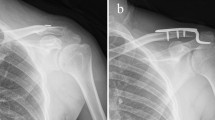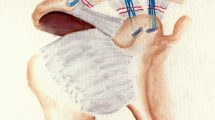Abstract
Purpose
Traumatic high-grade acromioclavicular joint (ACJ) separations can be surgically stabilized by numerous anatomic and non-anatomic procedures. The return to sport (Maffe et al. in Am J Sports Med 23:93–98, 1995] and remaining sport-associated impairments after acute ACJ stabilization has not yet been investigated.
Methods
73 consecutive athletes with acute high-grade ACJ separation were prospectively assigned into two groups (64.4% randomized, 35.6% intention-to-treat): open clavicular hook plate (cHP) implantation (GI) or arthroscopically assisted double double-suture-button (dDSB) implantation (GII). Patients were analyzed using shoulder sport-specific measurement tools for sport ability (ASOSS), sport activity (SSAS), and numerical analog scales: NASpain during sport, NASshoulder function in sport, and NASre-achievement of sport level. Four points of examination were established: preoperative evaluation (FU0) and first postoperative follow-up (FU1) at 6 months; FU2 at 12 months; and FU3 at 24 months after surgery. The control group (GIII) consisted of 140 healthy athletes without anamnesis of prior macro-injury or surgery.
Results
After surgical stabilization, 29 of 35 athletes in GI (82.9%; 38.6 ± 9.9 years) and 32 of 38 in GII (82.9%; 38.6 ± 9.9 years) were followed up for 24 months (FU3) (loss 17.8%). All operated athletes showed significantly increased scores compared to FU0 (p < 0.05). Compared to GI, GII showed significantly superior outcome data for sporting ability as well as for NASre-achievement of sport level (p < 0.05). While GII re-achieved GIII-comparable SSAS and ASOSS levels, GI remained at a significantly inferior level. Athletes after ACJ injury of Rockwood grade IV/V and overhead athletes benefited significantly from the dDSB procedure.
Conclusion
The dDSB procedure enabled significantly superior sport-specific outcomes compared to the cHP procedure. Athletes after dDSB surgeries re-achieved the sporting ability and the sport activity levels of healthy athletes, whereas athletes after cHP implantation remained at significantly inferior levels. The more extensive dDSB procedure and the more restrictive rehabilitation are recommended for treatment of acute high-grade ACJ separations of functionally high-demanding athletes.
Level of evidence
I.

Similar content being viewed by others
References
Abrams JS (2007) Role of arthroscopy in treating anterior instability of the athlete’s shoulder. Sports Med Arthrosc 15:230–238
Baskurt Z, Baskurt F, Gelecek N, Ozkan MH (2011) The effectiveness of scapular stabilization exercise in the patients with subacromial impingement syndrome. J Back Musculoskelet Rehabil 24:173–179
Bath SS, Bath SS, Tehranzadeh J (2012) Anterosuperior glenoid impingement syndrome. Clin Med Insights Arthritis Musculoskelet Disord 5:15–18
Beitzel K, Cote MP, Apostolakos J, Solovyova O, Judson CH, Ziegler CG et al (2013) Current concepts in the treatment of acromioclavicular joint dislocations. Arthroscopy 29:387–397
Brophy RH, Gill CS, Lyman S, Barnes RP, Rodeo SA, Warren RF (2011) Effect of shoulder stabilization on career length in national football league athletes. Am J Sports Med 39:704–709
Buteau JL, Eriksrud O, Hasson SM (2007) Rehabilitation of a glenohumeral instability utilizing the body blade. Physiother Theory Pract 23:333–349
Darabos N, Vlahovic I, Gusic N, Darabos A, Bakota B, Miklic D (2015) Is AC TightRope fixation better than Bosworth screw fixation for minimally invasive operative treatment of Rockwood III AC joint injury? Injury 46(Suppl 6):S113–S118
Fessa CK, Peduto A, Linklater J, Tirman P (2015) Posterosuperior glenoid internal impingement of the shoulder in the overhead athlete: pathogenesis, clinical features and MR imaging findings. J Med Imaging Radiat Oncol 59:182–187
Horst K, Dienstknecht T, Andruszkow H, Gradl G, Kobbe P, Pape HC (2013) Radiographic changes in the operative treatment of acute acromioclavicular joint dislocation—tight rope technique vs. K-wire fixation. Pol J Radiol 78:15–20
Jobe FW, Kvitne RS, Giangarra CE (1989) Shoulder pain in the overhand or throwing athlete. The relationship of anterior instability and rotator cuff impingement. Orthop Rev 18:963–975
Jobe FW, Pink M (1994) The athlete’s shoulder. J Hand Ther 7:107–110
Kibler WB (1998) The role of the scapula in athletic shoulder function. Am J Sports Med 26:325–337
Kibler WB, Sciascia A (2010) Current concepts: scapular dyskinesis. Br J Sports Med 44:300–305
Korsten K, Gunning AC, Leenen LP (2014) Operative or conservative treatment in patients with Rockwood type III acromioclavicular dislocation: a systematic review and update of current literature. Int Orthop 38:831–838
Kraus N, Haas NP, Scheibel M, Gerhardt C (2013) Arthroscopically assisted stabilization of acute high-grade acromioclavicular joint separations in a coracoclavicular Double-TightRope technique: V-shaped versus parallel drill hole orientation. Arch Orthop Trauma Surg 133:1431–1440
Lajtai G, Pfirrmann CW, Aitzetmuller G, Pirkl C, Gerber C, Jost B (2009) The shoulders of professional beach volleyball players: high prevalence of infraspinatus muscle atrophy. Am J Sports Med 37:1375–1383
Longo UG, Ciuffreda M, Rizzello G, Mannering N, Maffulli N, Denaro V (2017) Surgical versus conservative management of Type III acromioclavicular dislocation: a systematic review. Br Med Bull 122:31–49
Maffet MW, Gartsman GM, Moseley B (1995) Superior labrum-biceps tendon complex lesions of the shoulder. Am J Sports Med 23:93–98
Natera-Cisneros L, Sarasquete-Reiriz J, Escola-Benet A, Rodriguez-Miralles J (2016) Acute high-grade acromioclavicular joint injuries treatment: arthroscopic non-rigid coracoclavicular fixation provides better quality of life outcomes than hook plate ORIF. Orthop Traumatol Surg Res 102:31–39
Nuchtern JV, Sellenschloh K, Bishop N, Jauch S, Briem D, Hoffmann M et al (2013) Biomechanical evaluation of 3 stabilization methods on acromioclavicular joint dislocations. Am J Sports Med 41:1387–1394
Pallis M, Cameron KL, Svoboda SJ, Owens BD (2012) Epidemiology of acromioclavicular joint injury in young athletes. Am J Sports Med 40:2072–2077
Rios CG, Arciero RA, Mazzocca AD (2007) Anatomy of the clavicle and coracoid process for reconstruction of the coracoclavicular ligaments. Am J Sports Med 35:811–817
Saier T, Plath JE, Beitzel K, Minzlaff P, Feucht JM, Reuter S et al (2016) Return-to-activity after anatomical reconstruction of acute high-grade acromioclavicular separation. BMC Musculoskelet Disord 17:145
Saier T, Venjakob AJ, Minzlaff P, Fohr P, Lindell F, Imhoff AB et al (2015) Value of additional acromioclavicular cerclage for horizontal stability in complete acromioclavicular separation: a biomechanical study. Knee Surg Sports Traumatol Arthrosc 23:1498–1505
Salzmann GM, Paul J, Sandmann GH, Imhoff AB, Schottle PB (2008) The coracoidal insertion of the coracoclavicular ligaments: an anatomic study. Am J Sports Med 36:2392–2397
Salzmann GM, Walz L, Buchmann S, Glabgly P, Venjakob A, Imhoff AB (2010) Arthroscopically assisted 2-bundle anatomical reduction of acute acromioclavicular joint separations. Am J Sports Med 38:1179–1187
Scheibel M, Droschel S, Gerhardt C, Kraus N (2011) Arthroscopically assisted stabilization of acute high-grade acromioclavicular joint separations. Am J Sports Med. https://doi.org/10.1177/0363546511399379
Scheibel M, Ifesanya A, Pauly S, Haas NP (2008) Arthroscopically assisted coracoclavicular ligament reconstruction for chronic acromioclavicular joint instability. Arch Orthop Trauma Surg 128:1327–1333
Smith TO, Chester R, Pearse EO, Hing CB (2011) Operative versus non-operative management following Rockwood grade III acromioclavicular separation: a meta-analysis of the current evidence base. J Orthop Traumatol 12:19–27
Snyder SJ, Banas MP, Karzel RP (1995) An analysis of 140 injuries to the superior glenoid labrum. J Shoulder Elbow Surg 4:243–248
Soldatis JJ, Moseley JB, Etminan M (1997) Shoulder symptoms in healthy athletes: a comparison of outcome scoring systems. J Shoulder Elbow Surg 6:265–271
Stein T, Buckup J, Efe T, von Eisenhart-Rothe R, Hoffmann R, Zimmermann E et al (2015) Structural and clinical integrity of the rotator cuff in athletes after arthroscopic Bankart repair using the three-portal technique. Arch Orthop Trauma Surg 135:369–382
Stein T, Linke RD, Buckup J, Efe T, von Eisenhart-Rothe R, Hoffmann R et al (2011) Shoulder sport-specific impairments after arthroscopic Bankart repair: a prospective longitudinal assessment. Am J Sports Med 39:2404–2414
Tegner Y, Lysholm J (1985) Rating systems in the evaluation of knee ligament injuries. Clin Orthop Relat Res 198:43–49
Venjakob AJ, Salzmann GM, Gabel F, Buchmann S, Walz L, Spang JT et al (2013) Arthroscopically assisted 2-bundle anatomic reduction of acute acromioclavicular joint separations: 58-month findings. Am J Sports Med 41:615–621
Vrgoc G, Japjec M, Jurina P, Gulan G, Jankovic S, Sebecic B et al (2015) Operative treatment of acute acromioclavicular dislocations Rockwood III and V-comparative study between K-wires combined with FiberTape((R)) vs. TightRope System((R)). Injury 46(Suppl 6):S107–S112
Walz L, Salzmann GM, Fabbro T, Eichhorn S, Imhoff AB (2008) The anatomic reconstruction of acromioclavicular joint dislocations using 2 TightRope devices: a biomechanical study. Am J Sports Med 36:2398–2406
Weiser L, Nuchtern JV, Sellenschloh K, Puschel K, Morlock MM, Rueger JM et al (2017) Acromioclavicular joint dislocations: coracoclavicular reconstruction with and without additional direct acromioclavicular repair. Knee Surg Sports Traumatol Arthrosc 25:2025–2031
Zeichen J, Meller R, Siegel A, Gehrke A, Hecker H, Krettek C (2004) Is the shoulder sport activity after shoulder injuries quantifiable? Implementation of a new Shoulder Sport Activity Score. Paper presented at German congress for orthopedy and traumatology, 25 Oct 2004, Berlin
Acknowledgements
The authors appreciate the assistance of Dr. rer. med. Hanns Ackermann for collection and analyzing the data.
Funding
No funding exists.
Author information
Authors and Affiliations
Corresponding author
Ethics declarations
Conflict of interest
T. Stein has received payment for instructional courses. Other authors declare that they have no conflict of interest.
Ethical approval
The institutional ethics committee approved all data-collection and randomising procedures (clinical trial registry number: FF 42/2011).
Informed consent
All subjects provided informed consent.
Rights and permissions
About this article
Cite this article
Müller, D., Reinig, Y., Hoffmann, R. et al. Return to sport after acute acromioclavicular stabilization: a randomized control of double-suture-button system versus clavicular hook plate compared to uninjured shoulder sport athletes. Knee Surg Sports Traumatol Arthrosc 26, 3832–3847 (2018). https://doi.org/10.1007/s00167-018-5044-x
Received:
Accepted:
Published:
Issue Date:
DOI: https://doi.org/10.1007/s00167-018-5044-x




